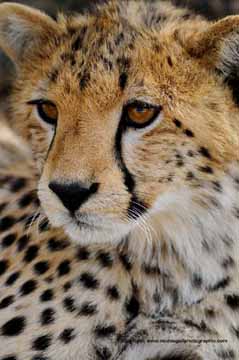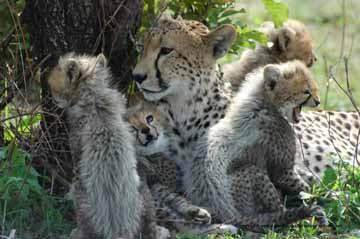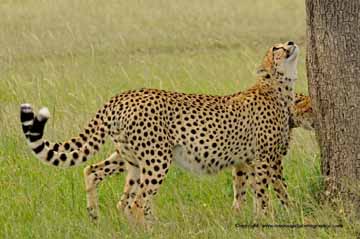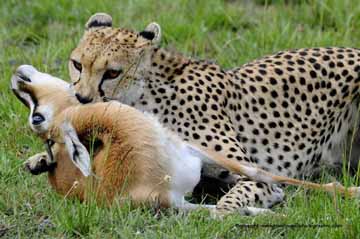Eco-travel
The Cheetah (Acinonyx jubatus)
-Paul McDougall
The Cheetah is the felid version of the greyhound, the most specialized of cats. It is known as the crying cat due to the teardrop markings underneath its eyes. The cheetah became extinct in India in the early 1950’s, and is now extremely rare elsewhere in
Asia and North Africa. It is still widely but sparsely distributed south of the Sahara in savannah and semi arid areas, but it has greatly reduced in numbers ad range. The cheetah is far less adaptable to man than the leopard.

The cheetah is specialized to prey on the fastest antelopes, especially gazelles. No other mammal is as fast as the cheetah, which has a top speed of 90-112 kph. Unfortunately its speed is not matched by stamina. To capture its prey the cheetah has to overtake
it within 300m, it finds it hard getting within sprinting distance on open plains with no cover, optimum cheetah habitat therefore includes cover in the form of bushes, medium length grass, trees and broken ground. A cheetah can go 4 days without water if
necessary and will often travel to find a water source. The cheetah is active by day and although often seen in groups of 2 or more it is not a social cat, these groupings tend to be a female with sub-adult cubs, young adult siblings or coalitions of males.

Adult females are generally solitary and shy cats. In acquiring the speed to catch the fastest antelopes the cheetah sacrificed the strength and weapons needed to defend its kills and offspring against other predators. It is afraid of lions, surrenders its
kills to hyenas, and can even be intimidated by vultures – perhaps because it realizes that vultures will attract other predators. Cheetah are the most diurnal cat, they do most of their hunting by daylight, but usually rest during the hottest hours, however
in Masai Mara it is thought that cheetah have adapted their behaviour to hunt in the middle of the day when there are less lodge vehicles in the park (most lodge clients go out on safari between 6 and 10 in the morning and 3 – 6 in the evening), this again
is evidence of the cheetahs shy nature. A Cheetahs vocal communication is unlike the sound of any other cat, especially the bird like chirping and chirring. Cheetahs give birth to on average 3 – 4 cubs although i have personally seen a cheetah in Mara with
7 cubs, gestation lasts approximately 3 months and the female withdraws in to thick cover to give birth, therefore cubs under 1 month old are rarely seen as she keeps them well hidden. Cheetah cubs begin practicing catching and killing for themselves well
before they become independent, the mother usually brings back a gazelle fawn and lets the cubs practice trying to catch it and kill it before they are even half a year old. Probably less than half of cheetah cubs survive the first 3 months as they have many
predators including lions, leopard, hyena and even larger eagles. Cheetahs in Kenya like in many countries are endangered due to the impact that man has had on their environment and also due to their fragile nature and struggle of bringing up cubs.

Cheetah ca be found in most Parks and Reserves in Kenya, but like the other big cats the best place to see them is Masai Mara especially at migration time when prey is plentiful and disturbance from other predators is minimal.
Masai Mara has given me many amazing moments with Cheetah, they can usually be seen in the Mara quite frequently as there are an abundance of their favorite prey species. The 2 moments that really stand out are the amazing female and her 7 cubs. I was lucky
enough to be able to spend 3 months in Kenya and during this period I visited Masai Mara frequently. During the first trip we came across this amazing female with her 7 tiny cubs, I managed to get a few shots of the cubs hiding in the long grass and following
their mum, but this was really just a taste of what was to come, over the next few months we managed to find this Cheetah and spent many hours with her and her cubs, as time went on she lost 2 cubs (we don’t know how), but she began to accept us being there,
so we watched the cubs grow up. We were fortunate enough to see them playing together, practicing hunting and stalking techniques as well as watching their loving mum licking them and caring for them. It really was a treat to share this time with such a beautiful
wild cat. After the 3 months I left, and always asked for updates on my cheetah. She managed to raise 3 of the cubs in the end to adulthood, and sometimes we come across her or her adult cubs on safaris.
My other big Cheetah moment was in January 2008 – in the middle of the terrible post election violence that rocked Kenya to the core, with many people being killed, injured and losing their homes. We decided that despite the obvious dangers we would still go
to Masai Mara, so we did, and we had virtually the whole reserve to ourselves as other tourists had stayed away. It was on this safari that I saw my first Cheetah hunt and kill, all I can say is wow, we watched this female with her 3 cubs walking boldly in
the open, and looked with interest at the Thompson Gazelle and zebra in the distance, then this female left her cubs and started to hunt, she stalked a Thompsons Gazelle and then when close enough she took off after it , it was incredible to see her reach
top speed, we unfortunately didn’t see her catch it – she was just too quick, but we did manage to get there just as she administered the fatal neck bite, I managed to capture that image of the gazelles last moments. We were then able to watch as she called
her cubs, they came running and started to feed. We watched for an hour as they ate the carcass completely undisturbed, again a true photographic treat.

|